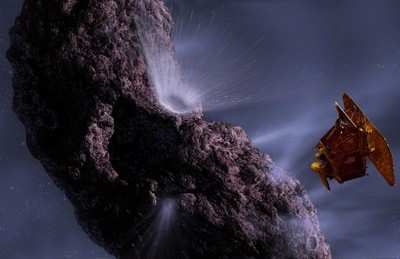Set To Go Comet-Hunting December 30th
NASA's Deep Impact spacecraft has arrived in Florida to begin
final preparations for a launch on December 30th. The spacecraft
was shipped from Ball Aerospace & Technologies in Boulder (CO),
to the Astrotech Space Operations facility located near the Kennedy
Space Center.

"Deep Impact has begun its journey to comet Tempel 1," said Rick
Grammier, Deep Impact project manager at NASA's Jet Propulsion
Laboratory. "First to Florida, then to space, and then to the comet
itself. It will be quite a journey and one which we can all witness
together."
The Deep Impact spacecraft is designed to launch a copper
projectile into the surface of Comet Tempel 1 on July 4, 2005, when
the comet is 83 million miles from Earth. When this 820-pound
"impactor" hits the surface of the comet at approximately 23,000
miles per hour, the 3-by-3 foot projectile will create a crater
several hundred feet in size. Deep Impact's "flyby" spacecraft will
collect pictures and data of the event. It will send the data back
to Earth through the antennas of the Deep Space Network.
Professional and amateur astronomers on Earth will also be able to
observe the material flying from the comet's newly formed crater,
adding to the data and images collected by the Deep Impact
spacecraft and other telescopes. Tempel 1 poses no threat to Earth
in the foreseeable future.
Deep Impact is being removed from its shipping container, the
first of the numerous milestones to prepare it for launch. Later
this week, the spacecraft begins functional testing to verify its
state of health after the over-the-road journey from Colorado. This
will be followed by loading updated flight software and beginning a
series of Mission Readiness Tests. These tests involve the entire
spacecraft flight system that includes the flyby and impactor, as
well as the associated science instruments and the spacecraft's
basic subsystems.
Next, the high gain antenna used for spacecraft communications
will be installed. The solar array will then be stowed and an
illumination test performed as a final check of its performance.
Next, Deep Impact will be ready for fueling preparations. Once this
is complete, the 2,152-pound spacecraft will be mated atop the
upper stage booster, the Delta rocket's third stage. The integrated
stack will be installed into a transportation canister in
preparation for going to the launch pad in mid-December.
Once at the pad and hoisted onto the Boeing Delta II rocket, a
brief functional test will be performed to re-verify spacecraft
state of health. Next will be an integrated test with the Delta II
before installing the fairing around the spacecraft.

Deep Impact mission scientists are confident such an intimate
glimpse beneath the surface of a comet, where material and debris
from the formation of the Solar System remain relatively unchanged,
will answer basic questions about the formation of the Solar System
and offer a better look at the nature and composition of these
celestial wanderers.
Launch aboard the Boeing Delta II rocket is scheduled to occur
on Dec. 30, 2004 from Launch Complex 17 at Cape Canaveral Air Force
Station. The launch window extends from 1439 - 1519 EST.
The overall Deep Impact mission management for this Discovery
class program is conducted by the University of Maryland in College
Park. Deep Impact project management is by the Jet Propulsion
Laboratory in Pasadena (CA). The spacecraft has been built for NASA
by Ball Aerospace and Technologies Corporation. The
spacecraft/launch vehicle integration and launch countdown
management are the responsibility of the Launch Services Program
office headquartered at Kennedy Space Center.
 ANN's Daily Aero-Term (04.25.24): Airport Rotating Beacon
ANN's Daily Aero-Term (04.25.24): Airport Rotating Beacon ANN's Daily Aero-Linx (04.25.24)
ANN's Daily Aero-Linx (04.25.24) Klyde Morris (04.22.24)
Klyde Morris (04.22.24) Airborne 04.24.24: INTEGRAL E, Elixir USA, M700 RVSM
Airborne 04.24.24: INTEGRAL E, Elixir USA, M700 RVSM Airborne 04.22.24: Rotor X Worsens, Airport Fees 4 FNB?, USMC Drone Pilot
Airborne 04.22.24: Rotor X Worsens, Airport Fees 4 FNB?, USMC Drone Pilot




